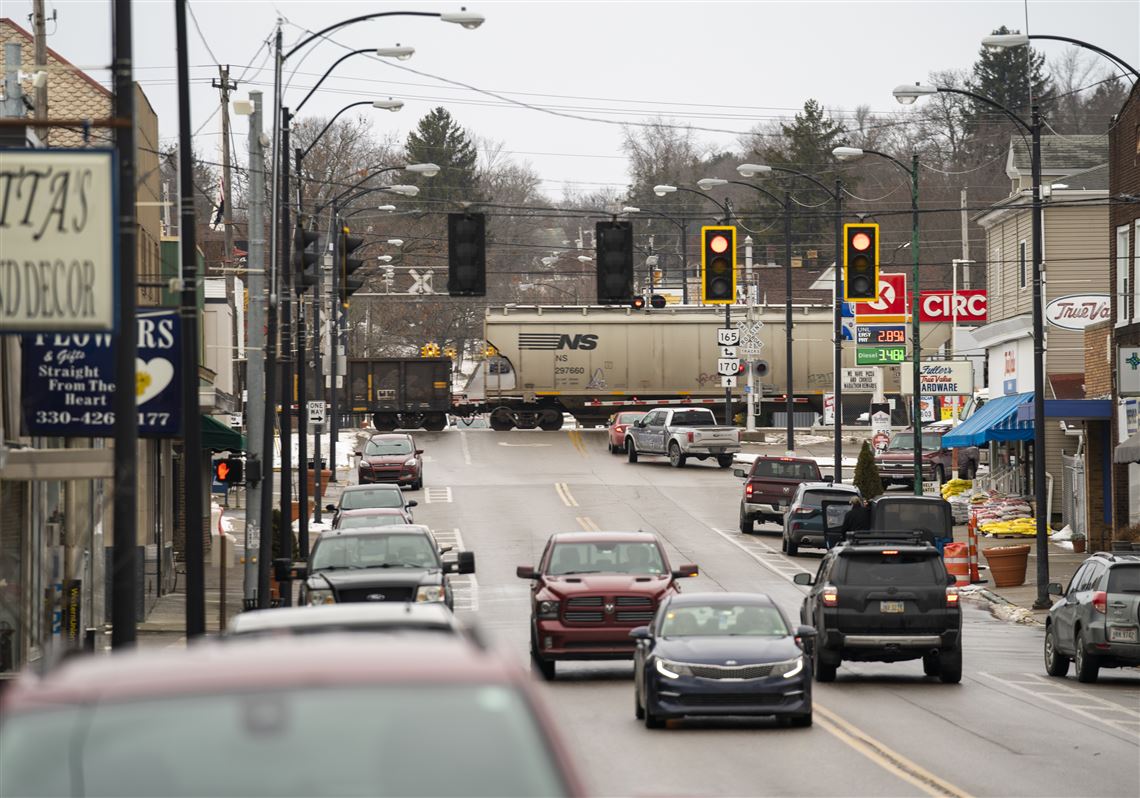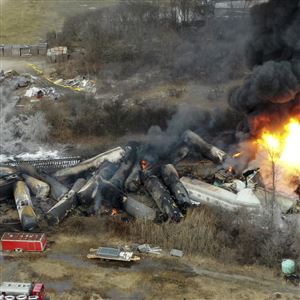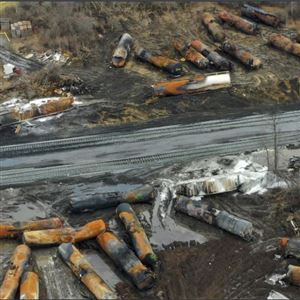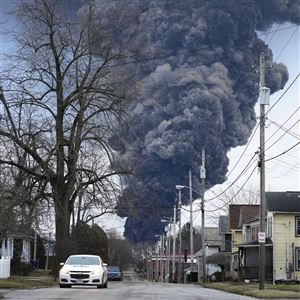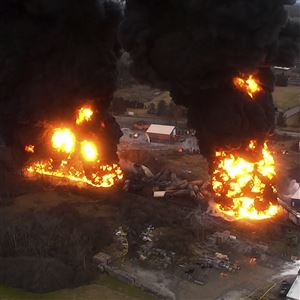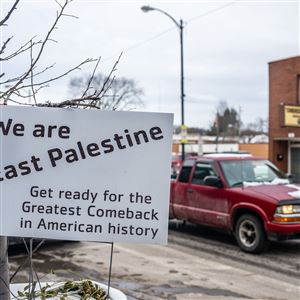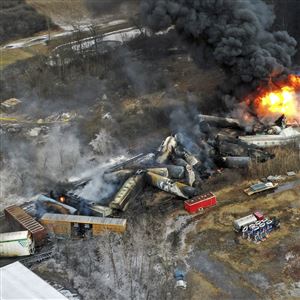Krissy Ferguson didn’t know how to explain to her parents what had happened.
A train derailment on the night of Feb. 3, 2023, forced the East Palestine family out of the home they’d lived in since 1970. For her 90-year-old stepfather Bob with dementia and her 82-year-old mother Norma with Parkinson’s, the abrupt upending of their lives was difficult to grasp.
“Do we get to come home today?’” her mother would frequently ask Ms. Ferguson at the hotel they stayed in last February.
“Not today, Mom,” Ms. Ferguson would respond. “I’ll try to find out.”
Nearly a year later, Ms. Ferguson still doesn’t have an answer. The family of six, which includes her parents, fiancé, daughter and her daughter’s boyfriend, remains displaced. They have since moved into a three-bedroom rental in Columbiana, about a 20-minute drive from East Palestine.
She placed small cardboard signs on the doors of bedrooms and other parts of the rental house to help her stepfather navigate the new surroundings. She noticed that he became depressed when he struggled to know where he was. He’s just now starting to feel comfortable.
He has fleeting moments of clarity — when the family drives to East Palestine to collect reimbursement payments from Norfolk Southern or when an update about East Palestine flashes across a TV news broadcast.
“Isn’t that where we used to live?” her stepfather asks. “Is that what happened? Is that why we’re not there?”
Almost a year has passed since the Norfolk Southern train derailment spewed toxic chemicals into the air, soil and water of a small village near the Ohio-Pennsylvania border. Dozens of cars derailed and burst into flames, 20 of which were reported to have been carrying vinyl chloride, butyl acrylate and numerous other hazardous chemicals with known health risks.
Despite the nearing anniversary, the recovery is still a work in progress. Crews have hauled over 44 million gallons of wastewater and 176,000 tons of solid waste off the derailment site, with the excavation of contaminated soil completed in October. The railroad is focused on backfilling new stone and gravel near the tracks, which remain an active construction site. Upwards of 75 to 100 trucks carrying waste from the site have traveled through East Palestine daily.
Norfolk Southern’s mandated testing in two creeks that run through East Palestine, Leslie Run and Sulfur Run, both of which still glimmer with a rainbow-colored sheen, are nearly complete.
Even as the U.S. Environmental Protection Agency continues to oversee the cleanup and offers assurances that ongoing monitoring indicates no current health hazards to the community, results from independent studies have yielded mixed results and experts have questioned the agency’s testing protocols. Residents still struggle to make confident decisions about their safety.
And time is running out for Ms. Ferguson and 40 other residents who are still relying on relocation funds from Norfolk Southern. The company’s temporary assistance program is scheduled to end Feb. 9. With no plans from the EPA or Norfolk Southern to retest their homes for chemicals, residents are in limbo.
“The EPA and Norfolk Southern want to know what can be done to get me back in my home, and there’s nothing that can be done,” Ms. Ferguson said. “I have said since day one that our home is contaminated.”
Ms. Ferguson’s home was exactly the set-up her family needed. The downstairs area, where her parents primarily stayed, and the second floor, where the rest of the family lived, each have their own kitchen, living room, bathrooms and bedrooms.
“It was the perfect home for us,” she said.
After the derailment, the family spent 32 challenging days in a hotel. The door was too heavy for her parents to open and close, and they had trouble working the keycard. Because her mother couldn’t leave the room on her own to exercise or walk, Ms. Ferguson noticed worsening hand tremors and “Pisa syndrome,” a condition in which Parkinson’s patients tilt to one side.
Ms. Ferguson went to Norfolk Southern for help. “I see my mom [and] stepfather becoming more depressed,” she told workers.
They found the family the Columbiana house in March, something she is thankful for. But relying on a railroad company for a place to sleep — especially when the lease is in the railroad’s name — left her uneasy.
“That was scary because every night when you lay down to sleep, you think, ‘Are they going to call tomorrow and tell us we have to move out?’” she said.
In the initial weeks after the derailment, she — like many other residents – wasn’t staying silent. She spoke out publicly about concerns that the EPA’s air monitors were providing inconsistent readings and that she was experiencing side effects from even short visits to her home.
“I could not keep that quiet and live the rest of my life from now on knowing I could have helped somebody if I would have spoken out,” she said.
EPA Administrator Michael Regan toured Ms. Ferguson’s house in mid-February and admitted he detected an odor. She told reporters at the time that East Palestine needed assistance from the Federal Emergency Management Agency, which initially refused to help before reversing course a day later.
In September, President Joe Biden ordered a FEMA coordinator to assist onsite. Ms. Ferguson also pleaded for a visit from Mr. Biden, who just announced Wednesday that he would come.
The help seemed too slow and incomplete to her. “I thought the government would protect us,” Ms. Ferguson said. “I thought we lived in the greatest country in the world.”
The East Palestine native has spent much of the past year seeking to understand what is happening with her health and house. In May, she got medical testing at a clinic in Cleveland that she said detected vinyl chloride in her urine.
Soil testing from a Norfolk Southern contractor soon after the derailment showed high levels of benzene. Multiple rounds of independent testing by Scott Smith, chief sustainability officer for Eco Integrated Technologies, later found dioxin levels in her furnace filter were eight times higher than the controlled sample. Mr. Smith discovered dioxin levels in soil near the derailment site were between 27,000% and 164,000% above control samples.
Now, she faces a difficult choice when the lease on her rental comes to an end.
“I will not take [my parents] back,” she said. “Do we become homeless? I mean, this home has been paid off since 1970.”
Health concerns linger
From the earliest town hall meetings, which often left residents more frustrated than assured, Stephen Lester, science director of the Virginia-based Center for Health, Environment & Justice, heard the same things over and over from those who live in East Palestine. Mr. Lester previously served as an environmental consultant for one of the worst environmental disasters in U.S. history, Love Canal. The area, near Niagara Falls, N.Y., was a dumping ground for nearly 22,000 tons of chemical waste, including dioxin.
The East Palestine folks repeatedly asked the same questions, Mr. Lester said: “’Can I go back home? Is it safe? Can I cut my grass in my yard? What’s going to happen to my 2-year-old if I bring him into this house?’ Those are the kinds of questions that people ask about the Love Canal, and those are the kinds of questions that I’ve heard when I was there, starting two weeks after the accident.”
He heard similar health concerns, too, largely about respiratory problems. But he said officials were quick to dismiss residents’ symptoms. A community survey conducted by the Ohio Department of Health showed that most residents reported congestion, coughing, eye irritation, headaches and other symptoms.
“The communities have the feeling that something is certainly not right, and they don’t know why they’re having these reactions,” he said. “The crux of the problem that exists right now is that conundrum between what people are experiencing and what EPA is saying.”
East Palestine residents could have been exposed to many contaminants during the derailment and after the railroad vented and burned the contents of five tanker cars, he said. But scientific understanding of what happens to people who come into contact with this multiple, low-level concentrations of chemicals remains “very primitive.”
“So when EPA says that everything is fine, it’s not based on some understanding of what happens to people in response to mixtures of these chemicals at low concentrations,” he said. “It’s based on their understanding of what will happen if you are exposed to this one or that one.”
Community members had to unravel seemingly conflicting messages. One study, from the Texas A&M University Superfund Research Center and Carnegie Mellon University, corroborated the EPA’s air quality findings; another from Purdue University found acute health threats inside several buildings around the derailment site and along Sulfur Run. The researchers demanded additional indoor chemical testing.
In an interview, EPA regional administrator Debra Shore said the agency is confident in the science. As part of an approved work plan from Norfolk Southern, the agency is overseeing final comprehensive sampling to confirm cleanup actions have been thorough. Throughout this past year, the EPA has collected more than 45,000 samples of soil, water and air, along with checking more than 115 million air monitoring points, she said.
When it comes to some of those independent test results, including Mr. Smith’s, EPA supervisory engineer Mark Durno wants to see more quality assurance.
“It’s hard for us to really evaluate what they’ve done,” he said. “In addition to that, the limited amount of soil sampling I have seen actually looks exactly the same in the same data ranges as ours. I don’t know where those concerns are coming from. They’ve done indoor sampling, and the indoor sampling doesn’t have any comparative values.”
And when asked about the possibility of testing homes again, which many residents want and lawmakers have requested, Mr. Durno said it depends on whether investigators find evidence of contamination migrating away from the site.
“We base our decisions in science and the sophisticated and redundant array of outdoor air monitors and samplers,” he said. “All these different tests provided real data that showed there was no pathway on these properties. If that continues to be the same, we don’t see a need to go back to these properties.”
Mr. Durno did say Ms. Ferguson’s home had a pathway to chemical exposure because it sits right over Sulfur Run. But, according to the EPA, the home is not considered a health hazard from volatile chemicals released during the incident, and all potential exposure pathways have been removed.
But Ms. Ferguson still isn’t confident in the home’s safety. “I’ve been battling with them since day one,” she said.
An East Palestine that looks unfamiliar
Tracy Hager remembers moments when she broke down on the back porch of her camper rental in Salem, Ohio. Sometimes, all the changes became just too much, and she didn’t want her kids to see her upset.
“I wanted to go home so badly,” she said.
As part of Norfolk Southern’s relocation program, Ms. Hager and her family temporarily moved into a campground 18 miles west of East Palestine. They would be able to keep it for the season, from April to October.
The family’s commute time doubled between Ms. Hager’s and her husband, Brian’s, jobs. Ms. Hager took on a second job as a housekeeper for the campground to make extra money. Her boys, Colton, 12, and Camden, 10, also attended school in East Palestine three times a week, with virtual learning in between.
Leery but eager to return to a normal routine, the family decided to return to their 16-foot-by-80-foot mobile home in East Palestine.
But the move didn’t bring much comfort. She woke up with rashes and lesions. She tore up her garden beds and power washed the house. She bought three filters, at a cost of more than $200 each. She scrubbed down as many surfaces as possible after Norfolk Southern contractors did what she felt was a superficial cleaning inside.
The village looks different, too. Her two-way street has turned into a one way, as crews tear up and replace water lines. The family next door, including a little boy around her youngest son’s age, is gone.
Some changes aren’t temporary. East Liverpool City Hospital opened a health clinic. The EPA set up a welcome center in an empty storefront. Norfolk Southern turned a banquet hall into an assistance center and plans to repurpose a former Brittain Motors building into its field office.
“It’s changed our town,” Ms. Hager said. “That’s from everything to the fact that people are moving, you’ve lost your friends and they’ve bought all these buildings.”
Even a church transformed into an operations hub. Bill Sutherin has served as a lay leader for the Centenary United Methodist Church and the church conference’s disaster response ministries for about 25 years. He’s never seen anything like this.
The over 150-year-old church that welcomes roughly 30 worshippers a week was suddenly opening its doors to Norfolk Southern, the federal EPA, National Transportation Safety Board and a flood of other officials. The property is one of the few in East Palestine with a big enough parking lot.
Within a month of the derailment, Norfolk Southern had signed a lease to take over nearly every room in the church except the sanctuary space, and they’ve shared the space since.
“In the beginning, it was a little adjustment,” Mr. Sutherin said. “They were so accommodating. The only issue has been the building was not designed — I mean, it’s an old building. But they pay for extra utilities they’re using. They were paying for any sewer work or any other work that’s involved because I have so many people there. They pay extra for the janitorial services from our church. It’s worked really well.”
Village Manager Chad Edwards took the job in October. A native of Marietta, Ohio, he visited East Palestine for the first time during an interview. He immediately connected to the small town culture. But knowing he hadn’t personally experienced this catastrophe, his goal was to come in with an open mind.
The rift between those who want to move past the disaster and those feeling more skeptical has reached a fever point for residents like Ms. Hager. Already losing friendships, she doesn’t go downtown, in an effort to avoid the tension. For Mr. Edwards, he doesn’t want people to draw hard lines.
“I think that there are several camps,” he said. “It’s a little bit more nuanced. You have people with different degrees of anger toward the railroad, different ideas on what steps should be taken. I think they’re doing a pretty good job of being corporately responsible.”
So far, Norfolk Southern has made $103 million worth of commitments in East Palestine, among the largest a $25 million upgrade to an 81-acre park and $25 million to build a regional training center for first responders.
Ms. Hager wonders whether the money flow affects the response from local leaders, motivating them to be more lenient toward the railroad in particular. Mr. Edwards said that’s not the case.
“There’s some people who think the city is corrupted, bought out,” he said. “I don’t have preconceived opinions. I’m starting from a clean slate, so my opinions are my own. I feel that’s the position of administrators, to be as neutral as possible.”
Norfolk Southern CEO Alan Shaw visited East Palestine on Jan. 15 for a media roundtable at the village’s Moose Lodge to tout the company’s commitment to “making it right,” its slogan since the beginning.
“My focus is on the community and the recovery,” he said. “We invested $1.3 million to upgrade the water system here. We’ve established a homeowners value assistance program. We’re working with key stakeholders on long-term health care. We just recently had a meeting with an economic development consultant. The key message is, since day one, we made a lot of promises. We’ve kept our promises, and we understand there’s more work to be done.”
Ms. Hager doesn’t want to be around for it. She and her husband have toured several campgrounds in the area to move to. Each time, she sees the interest dwindle when managers learn their camper is in East Palestine.
“It took us 10 years to build what we have, and then to have everybody tell us how it’s basically garbage — it’s just a lot for us,” she said. “It’s just too much, between the people in town and the lack of local support and just watching everybody bend over backwards once the money comes out for them.”
Hard to move on
The seismic changes to the East Palestine community have shifted everyday habits. A survey released in November found that a quarter of households feel unsafe using water for basic household activities, such as drinking or brushing teeth.
There were concerns that recovery services, such as reimbursement for relocation, were not delivered in an equitable and fair way.
It’s a matter of trust, too. Only 19% felt confident in EPA as a trusted source, and most did not trust Norfolk Southern’s information. Half of the respondents requested air, water or soil sampling. Of them, just over 60% had received the sampling and results. Most found results hard to understand. While residents were most confident in academic researchers as an information source, those often had limited funding immediately post-disaster.
Experts like Mr. Lester with The Center for Health, Environment & Justice say there wasn’t a clear playbook for this disaster.
“It’s a sad state of affairs,” he said. “When there’s an infectious disease like COVID, for example, or a food contamination problem, there are teams in place to come together with resources and experts and protocols in place to respond. There’s no expert team of researchers who come together to investigate this kind of a problem.”
Ms. Ferguson hopes Norfolk Southern could help her pay for another home. Since her family has become accustomed to the temporary place, she wonders whether they could stay there, but it’s not something they can afford on their own.
She just wants her family to regain a stable life, somewhere free of worries about what chemicals could be lingering in the carpet, basement, or yard.
“I can’t get out of Feb. 3,” Ms. Ferguson said. “You’re just left with more questions, never the answers. You can’t move on from that day when you don’t even know where your home’s going to be.”
Jordan Anderson: janderson@post-gazette.com
First Published: February 1, 2024, 10:30 a.m.
Updated: February 3, 2024, 8:40 p.m.






